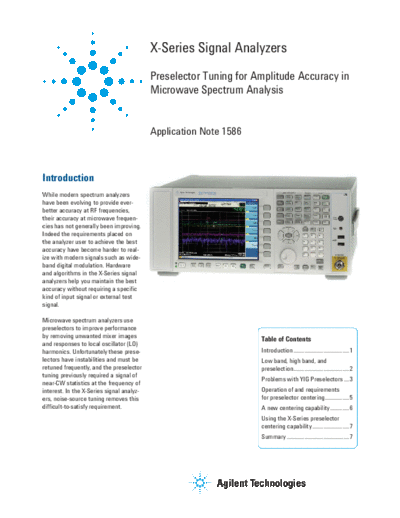Service Manuals, User Guides, Schematic Diagrams or docs for : HP Publikacje 5989-4946EN
<< Back | HomeMost service manuals and schematics are PDF files, so You will need Adobre Acrobat Reader to view : Acrobat Download Some of the files are DjVu format. Readers and resources available here : DjVu Resources
For the compressed files, most common are zip and rar. Please, extract files with Your favorite compression software ( WinZip, WinRAR ... ) before viewing. If a document has multiple parts, You should download all, before extracting.
Good luck. Repair on Your own risk. Make sure You know what You are doing.
Image preview - the first page of the document

>> Download 5989-4946EN documenatation <<
Text preview - extract from the document
X-Series Signal Analyzers
Preselector Tuning for Amplitude Accuracy in
Microwave Spectrum Analysis
Application Note 1586
Introduction
While modern spectrum analyzers
have been evolving to provide ever-
better accuracy at RF frequencies,
their accuracy at microwave frequen-
cies has not generally been improving.
Indeed the requirements placed on
the analyzer user to achieve the best
accuracy have become harder to real-
ize with modern signals such as wide-
band digital modulation. Hardware
and algorithms in the X-Series signal
analyzers help you maintain the best
accuracy without requiring a specific
kind of input signal or external test
signal.
Microwave spectrum analyzers use
preselectors to improve performance
by removing unwanted mixer images Table of Contents
and responses to local oscillator (LO)
harmonics. Unfortunately these prese- Introduction .........................................1
lectors have instabilities and must be Low band, high band, and
retuned frequently, and the preselector preselection .........................................2
tuning previously required a signal of
Problems with YIG Preselectors ....3
near-CW statistics at the frequency of
interest. In the X-Series signal analyz- Operation of and requirements
ers, noise-source tuning removes this for preselector centering..................5
difficult-to-satisfy requirement. A new centering capability ..............6
Using the X-Series preselector
centering capability ...........................7
Summary ..............................................7
Low Band, High Band, and Preselection
Modern spectrum analyzers operating 1st IF 2nd LO
up to 26.5 GHz have a "low band" and LPF amp
a "high band" signal path, as shown in
the simplified block diagram, Figure 1. LO LO IF
HI BPF HI out
The "low band" in the X-Series
signal analyzers covers frequencies
up to 3.6 GHz. In low band, the signal YIG-tuned LO
is upconverted to a high IF (5.1225 preselector HI
GHz), then downconverted to an IF of 1st LO
322.5 MHz. This double conversion
scheme dramatically reduces mixer Figure 1: Block diagram of low-band/high-band spectrum analyzer front end
image responses.
"High band" frequency ranges can-
not practically be built with the same
block diagram as low band because
the first IF amplifier would have
to work at a frequency where the
amplifier noise and distortion would
inevitably be higher than users want.
The alternative block diagram is a
single conversion to the IF frequency
as shown in Figure 1. In this block
diagram, image responses in the first
mixer are spaced by only twice the IF
frequency, or about 600 MHz. Such
images are unacceptable in a general
purpose spectrum analyzer. Thus the
tunable preselector (band-pass filter)
is used to filter out the images.
This filter is built using YIG (yttrium-
iron-garnet) technology. Spheres of
YIG material act to filter the signal
with a passband frequency that is con-
trolled by a magnetic field.
2
Problems with YIG Preselectors
YIG preselectors usually have a pass- Gain Peak Frequency
band width of about 40 to 80 MHz.
When used at frequencies up to 26.5 Factory calibration
GHz, the required Qs of the resonators of amplitude of
are very high. This high Q is accom- centered filter
4 dB
panied by amplitude and frequency
instabilities. Midpoint
◦ Jabse Service Manual Search 2024 ◦ Jabse Pravopis ◦ onTap.bg ◦ Other service manual resources online : Fixya ◦ eServiceinfo